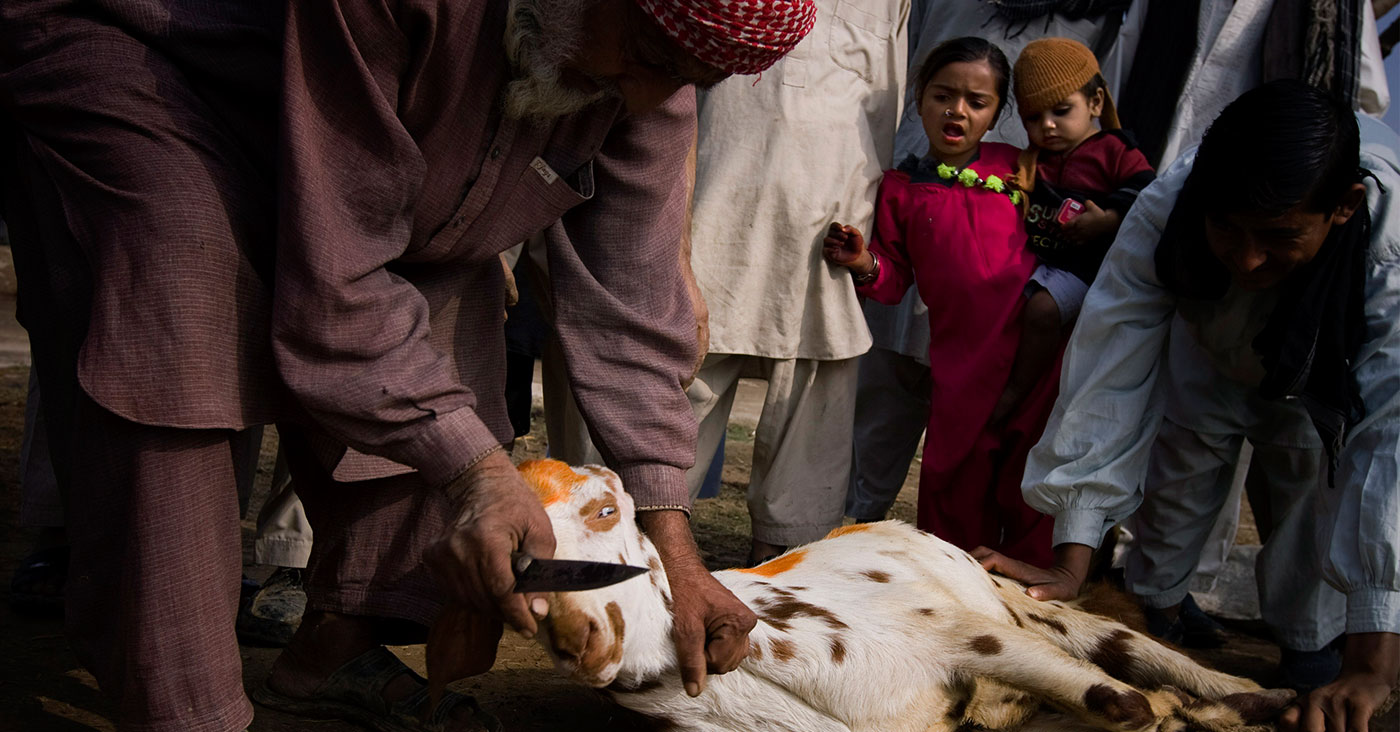Ritual sacrifice and urban life
Depending on the country, the festival of the sacrificial sheep takes place legally or clandestinely, in urban and rural areas, in both Muslim and secular countries. Traditionally, it is the father of the family who performs the ritual, passing on the values and techniques to his sons. It is a ‘festival of commemoration’, focusing on sharing and hospitality and, today, brings together family customs and religious precepts, tradition and modernity.
The family home as a place of sacrifice
For those who do not make the pilgrimage to Mecca, Eid al-Adha otherwise known as the ‘festival of sacrifice’, now mainly takes place in the family home. Although each family celebrates individually, the festival is a collective ritual, carried out at the same time by all members of the practising Muslim community. The last prayer of the festival marks the moment when the sheep’s throat is cut in accordance with halal precepts, which follow the Muslim ritual. In the past, villages and nomad camps joined together for these sacrificial rituals. Today, although the majority of Muslims live in urban areas governed by health and safety laws, towns either do not allow or make little room for this event, particularly in secular countries.
Urban sheep-folds and makeshift abattoirs
In Muslim towns, notably in the Maghreb and in Western Africa, ‘fairs’ are held several weeks before the festival. These livestock markets are supplied with sheep from various sources which have undergone health checks. The father of the family carries out the traditional role of choosing the animal he will sacrifice, preferring a heavy, healthy-looking animal with large horns. Once the sheep has been bought, taking care of it until its slaughter can be problematic, with buildings becoming urban sheep-folds (Brisebarre, n.d.). Living in a block of flats also makes ritual slaughter complicated. Space is often allocated in the courtyard in front of the building and is washed and purified in accordance with the rules.
The difficulty in pursuing the tradition in urban areas has also lead to the gradual loss of families passing on ‘knowhow of throat-cutting’. Specialised butchers are therefore taking the place of the fathers of the family, in return for a small payment.
In European Union countries, legislation governing the conditions of ritual slaughter, consider the Eid al-Adha sheep as a simple animal for slaughter. As such, it must be slaughtered in an abattoir by a professional and not by the head of the family. In France, where the majority of the Muslim population lives in towns, these restrictions have resulted in clandestine sacrifices. The lack of available abattoirs has only served to exacerbate the phenomenon in large urban areas. In an attempt to address this issue, the younger generation of Muslims now creates temporary, regulated slaughter sites.
‘e-Sacrifice’: tradition and modern solutions
The internet has paved the way for some original solutions to the issues surrounding ritual slaughter. In 2006, a website based in Morocco began offering the online sale of sacrificial animals in accordance with Muslim principles, delivering them to the customer on the day they are to be sacrificed. For urban dwellers, this solves the problem of where to keep the animal, but they still need to find a place to slaughter it. In Pakistan, certain Muslim charities, such as the Alamgir Welfare Trust, offer ‘e-Sacrifices’ whereby it is possible to buy or sponsor a sheep and watch its sacrifice live online ”wherever you live”. The meat can then be collected and/or shared out among the needy.
Alamgir Welfare Trust [en ligne], organisme musulman de bienfaisance, mis à jour 2013. [Consulté le 22 septembre 2015]. Disponible à l’adresse : http://www.alamgirwelfaretrust.com.pk
Commander son mouton sur internet, c’est désormais possible… au Maroc. Huffington Post Algérie [en ligne]. Le 24 septembre 2014. [Consulté le 23 septembre 2015]. Disponible à l’adresse : http://www.huffpostmaghreb.com
Sardi.ma [en ligne], vente online de moutons de l’Aïd, mis à jour 2014-2015. [Consulté le 23 septembre 2015]. Disponible à l’adresse : http://sardi.ma
BRISEBARRE, Anne-Marie, 1998. La fête du mouton. Un sacrifice musulman dans l’espace urbain, Paris : CNRS éditions.
BRISEBARRE, Anne-Marie, s.d.. Les espaces du sacrifice de l’Ayd al-Kâbir en milieu urbain. Maghreb, Afrique de l’Ouest, Europe. Les Annales de la recherche urbaine. S.d. N° 96, pp.44-52.
BRISEBARRE, Anne-Marie, 2007. Sacrifier pour l’Aïd El-Kébir en France. Texte exclusif OCHA [en ligne]. [Consulté le 22 septembre 2015]. Disponible à l’adresse : http://www.lemangeur-ocha.com
DECOBERT, Christian. 1991. Le mendiant et le combattant. L’institution de l’islam. Paris : Seuil.
HAMES, Constant, 1998. Le sacrifice animal au regard des textes islamiques canoniques. Archives de sciences sociales des religions. 1998. N° 101, pp. 5-25.
RODIER, Christine, 2014. La question halal. Sociologie d’une consommation controversée. Paris : PUF.








